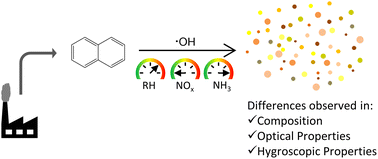Effect of relative humidity, NOx, and ammonia on the physical properties of naphthalene secondary organic aerosols†
Abstract
Light-absorbing organic aerosols, commonly referred to as “brown carbon” (BrC), have important climate effects. The primary source of BrC is biomass burning, but additional BrC can be formed by less constrained secondary atmospheric reactions, such as photooxidation of aromatic volatile organic compounds (VOCs) and reactions of carbonyl compounds in secondary organic aerosols (SOAs) with ammonia (NH3). As NH3 and VOC emissions increase globally, these insufficiently understood BrC production pathways may gain in importance relative to the primary BrC sources. This study examines the effects of NH3, NOx, and relative humidity (RH) on the optical and molecular properties of naphthalene (NAP) photooxidation SOAs. NAP SOAs were prepared by OH-initiated oxidation in a smog chamber at high and low levels of NOx, RH, and NH3. SOA hygroscopicity and optical properties were monitored online, and SOA samples were collected on filters for offline analysis. UV-visible spectroscopy and high-resolution mass spectrometry were used to determine mass absorption coefficients and molecular composition, respectively. Of the three parameters studied, RH exhibited the largest effects on both composition and optical properties – with an increase in the 〈O/C〉 ratio, relative dimer abundance, and absorption at wavelengths longer than 350 nm. Elevated NOx and NH3 concentrations increased the amount of nitrogen incorporated into the SOA, and NOx increased the amount of absorption at wavelengths longer than 350 nm while NH3 had little effect. The combination of elevated humidity and NOx led to the formation of 6-nitro-2-naphthol, a strong chromophore with a distinct peak at 400 nm in the absorption data. We find that RH, NOx, and NH3 all affect the characteristics of NAP SOAs in different ways: NOx and RH control both molecular composition and optical properties, while NH3 has a stronger effect on composition and a minor effect on the absorption coefficient.

- This article is part of the themed collections: Aerosols – Topic Highlight and Environmental Science: Atmospheres: Highlight USA & Canada


 Please wait while we load your content...
Please wait while we load your content...